1 of 15
Download to read offline
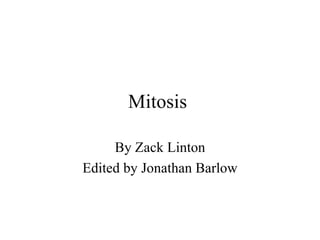














Recommended
The Phases Of Mitosis



The Phases Of Mitosispcerny
Ã˝
Cancer relates to mitosis, the process of cell division, because cancer needs mitosis to produce more cancer cells. Cancer cell division occurs faster than regular cell division, allowing cancer cells to quickly spread throughout the body. Both cancer cells and regular cells undergo mitosis, starting with a cell containing 92 chromosomes that divides into two cells with 46 chromosomes each. However, cancer cell mitosis happens more rapidly, producing more cancer cells than regular cells.The Phases Of Mitosis



The Phases Of Mitosispcerny
Ã˝
Mitosis is divided into 5 phases: Interphase where the cell grows and duplicates its DNA, Prophase where the chromosomes condense, Metaphase where the chromosomes align in the center of the cell, Anaphase where the sister chromatids are pulled to opposite poles of the cell, and Telephase where the nuclear envelope reforms and the cell divides into two daughter cells.Powerpoint brain blg + quiet leadership



Powerpoint brain blg + quiet leadershipRobert Crommelin
Ã˝
This document discusses techniques for quiet leadership and transforming performance at work. It outlines 6 steps: 1) thinking about thinking, 2) listening for potential, 3) speaking with intent, 4) dancing toward insight, 5) creating new thinking, and 6) following up. Each step provides guidance on focus, questions, and approaches. Additionally, it discusses David Rock's SCARF model and qualities of effective followers including creating autonomy, managing themselves well, feeling free to be whistleblowers.Powerpoint quiet leadership



Powerpoint quiet leadershipRobert Crommelin
Ã˝
The document outlines six steps for transforming performance at work, as described by David Rock in 2006. The steps are: 1) think about thinking, 2) listen for potential, 3) speak with intent, 4) dance toward insight, 5) create new thinking, and 6) follow up. For each step, guidelines and considerations are provided. The document also discusses David Rock's SCARF model and characteristics of effective followers as described by Robert Kelly in 1988.Neuroscience - Change management with the brain in mind



Neuroscience - Change management with the brain in mindZukunft2020
Ã˝
An overview and introduction to neuroscience and neuropsychology and its application in change management.TNR2013 David Rock, The Neuroscience of Engagement



TNR2013 David Rock, The Neuroscience of EngagementSteven Wardell
Ã˝
This document discusses neuroleadership and how applying neuroscience can improve leadership practices. It provides information on:
1) The NeuroLeadership Institute which conducts research and offers education programs in applying neuroscience to leadership, coaching, change management and learning.
2) Various topics in neuroscience that relate to leadership such as engagement, decision making, stress, collaboration and organizational change.
3) How measuring engagement through various biological markers can provide more accurate insights than self-reports alone.
4) Suggestions for how leaders can increase employee engagement by appealing to brain regions and mechanisms related to status, certainty, autonomy, relatedness and fairness.NeuroLeadership in Organization Development 



NeuroLeadership in Organization Development Organization Development Network of Western New York
Ã˝
Contemporary research in neuroscience provides new insights into the deeply social nature of the human brain and its importance for how we get things done at work. The emerging practice of NeuroLeadership (a term coined by Dr. David Rock) incorporates the most recent findings from neuroscience research with the latest in leadership theory.
This workshop will explore the brain science of social interactions, why they matter so much and why change is often so difficult. The SCARF brain-based model for collaborating with and influencing others will be introduced. We’ll look at how our brains respond when we interact with other people and how this knowledge can be applied to boost performance.
Key outcomes will be to improve everyday coaching conversations and to learn to strategically apply science to human performance.
http://concentricleadership.com Quiet Leadership



Quiet LeadershipKriengsak Niratpattanasai
Ã˝
The document discusses coaching techniques for unleashing human potential. It covers 3 parts: the brain, 6 steps for coaching, and applications. Regarding the brain, it notes that no two brains are alike, the brain is a connection machine that hardwires everything, and it's easy to create new wiring through positive reinforcement. The 6 coaching steps are: 1) think about thinking, 2) listen for potential, 3) speak with intent, 4) dance toward insight, 5) create new thinking, and 6) follow up. Applications include using questioning to help people think at a higher level and make new connections.The Phases Of Mitosis



The Phases Of Mitosispcerny
Ã˝
The document discusses mitosis and cancer. Cancer is caused by unregulated mitosis where the normal checkpoints of mitosis are ignored by cancer cells. Cancer begins when a single cell is transformed from a normal cell to a cancer cell without proper regulation of mitosis.mitosis



mitosispcerny
Ã˝
The document outlines the stages of mitosis in a cell cycle. It begins with interphase where the cell grows in size and copies its DNA. Then during prophase the chromosomes condense and become visible. The chromosomes then align in the center during metaphase and are pulled apart during anaphase. Finally, in telophase two new daughter cells form with identical sets of chromosomes.mitosis by ryan



mitosis by ryanpcerny
Ã˝
The document discusses mitosis and cancer. Cancer is caused by unregulated mitosis where the normal checkpoints of mitosis are ignored by cancer cells. Cancer begins when a single cell is transformed from a normal cell to a cancer cell without proper regulation of mitosis.MITOSIS



MITOSISpcerny
Ã˝
Mitosis is the process of cell division where the nucleus divides into two nuclei, each containing the same number of chromosomes as the original parent cell. During prophase, the chromatin condenses into distinct chromosomes, the nucleolus disappears, and the nuclear envelope breaks down. Chromosomes then align in the center of the cell before spindle fibers pull the identical sets of chromosomes to opposite ends of the cell during cell division. Errors during this process can lead to uncontrolled cell growth and the development of cancerous tumors.mitosis by joey



mitosis by joeypcerny
Ã˝
Mitosis is the process of cell division that results in two daughter cells each having the same number and type of chromosomes as the parent nucleus. It involves several steps: interphase where the cell grows and prepares for division, prophase where the chromosomes condense, prometaphase where the nuclear envelope breaks down, metaphase where the chromosomes align, anaphase where the chromosomes are separated, and telophase where the daughter nuclei and cells reform.Mitosis Powerpoint



Mitosis Powerpointpcerny
Ã˝
The document discusses the three main phases of mitosis: interphase, prophase, and metaphase. During interphase the cell grows and duplicates its DNA in preparation for division. In prophase the chromatin condenses into chromosomes and the nuclear envelope breaks down. During metaphase the chromosomes align in the center of the cell.Mitosis Presentation



Mitosis Presentationpcerny
Ã˝
The document outlines the stages of mitosis in a cell cycle. It lists interphase followed by prophase, metaphase, anaphase and telophase as the key stages, concluding with "The End!".Mitosis Presentation



Mitosis Presentationpcerny
Ã˝
Cancer is caused by uncontrolled mitosis, the process where a parent cell divides into two daughter cells. Mitosis allows cells to grow and divide but in cancer it occurs without regulation, causing tumors to form as extra cells accumulate that the body cannot eliminate.Mitosis Presentation



Mitosis Presentationpcerny
Ã˝
Mitosis is the process by which cells replicate and divide to form identical daughter cells. The nucleus contains most of the cell's genetic material in the form of DNA packaged into chromosomes - 23 pairs from the mother and 23 from the father, totaling 46. The nucleus is enclosed by a membrane and controls the functions of the cell, while the cell membrane forms the outer boundary and regulates what enters and exits the cell. Cancer is characterized by abnormal cell growth and there are over 100 types of cancer with varying symptoms and treatments that may include chemotherapy, radiation, and surgery.Mitosis



Mitosispcerny
Ã˝
Mitosis is the process where a parent cell divides into two daughter cells. The parent cell contains a nucleus and chromosomes. Through mitosis, the parent cell duplicates its chromosomes and divides itself and its contents evenly between the two new daughter cells.The phases of Mitosis By Stephanie



The phases of Mitosis By Stephaniepcerny
Ã˝
Mitosis is divided into 5 phases: Interphase where the cell grows and duplicates its DNA, Prophase where the chromosomes condense, Metaphase where the chromosomes align in the center of the cell, Anaphase where the sister chromatids are pulled apart to opposite ends of the cell, and Telephase where the cell divides into two daughter cells with identical sets of chromosomes.Mitosis stages



Mitosis stagespcerny
Ã˝
In this slideshow, the stages of mitosis is shown. step by step, it shows how a cell is created through cell divison or mitosis.Mitosis



Mitosispcerny
Ã˝
This document outlines the 5 stages of mitosis in a cell cycle: Interphase, Prophase, Metaphase, Anaphase, and Telephase. Each stage is represented by its order and a brief description.Mitosis Lab By Jon B



Mitosis Lab By Jon Bpcerny
Ã˝
This document provides an overview of the muscular system including:
1) Types of muscle such as cardiac, smooth, and skeletal muscle which makes up 40% of total body mass.
2) The microscopic structure of skeletal muscle including sarcomeres which contain actin and myosin filaments responsible for muscle contraction.
3) The sliding filament theory of muscle contraction involving interactions between actin, myosin, calcium, and ATP.
4) How nerve impulses trigger muscle contraction through the process of excitation-contraction coupling.
5) Causes of muscle fatigue including reduced ATP, lactic acid buildup, dehydration, and decreased nerve signals.Transform tomorrow: Master benefits analysis with Gen AI today webinar, 30 A...



Transform tomorrow: Master benefits analysis with Gen AI today webinar, 30 A...Association for Project Management
Ã˝
Transform tomorrow: Master benefits analysis with Gen AI today webinar
Wednesday 30 April 2025
Joint webinar from APM AI and Data Analytics Interest Network and APM Benefits and Value Interest Network
Presenter:
Rami Deen
Content description:
We stepped into the future of benefits modelling and benefits analysis with this webinar on Generative AI (Gen AI), presented on Wednesday 30 April. Designed for all roles responsible in value creation be they benefits managers, business analysts and transformation consultants. This session revealed how Gen AI can revolutionise the way you identify, quantify, model, and realised benefits from investments.
We started by discussing the key challenges in benefits analysis, such as inaccurate identification, ineffective quantification, poor modelling, and difficulties in realisation. Learnt how Gen AI can help mitigate these challenges, ensuring more robust and effective benefits analysis.
We explored current applications and future possibilities, providing attendees with practical insights and actionable recommendations from industry experts.Ã˝
This webinar provided valuable insights and practical knowledge on leveraging Gen AI to enhance benefits analysis and modelling, staying ahead in the rapidly evolving field of business transformation.More Related Content
More from pcerny (20)
The Phases Of Mitosis



The Phases Of Mitosispcerny
Ã˝
The document discusses mitosis and cancer. Cancer is caused by unregulated mitosis where the normal checkpoints of mitosis are ignored by cancer cells. Cancer begins when a single cell is transformed from a normal cell to a cancer cell without proper regulation of mitosis.mitosis



mitosispcerny
Ã˝
The document outlines the stages of mitosis in a cell cycle. It begins with interphase where the cell grows in size and copies its DNA. Then during prophase the chromosomes condense and become visible. The chromosomes then align in the center during metaphase and are pulled apart during anaphase. Finally, in telophase two new daughter cells form with identical sets of chromosomes.mitosis by ryan



mitosis by ryanpcerny
Ã˝
The document discusses mitosis and cancer. Cancer is caused by unregulated mitosis where the normal checkpoints of mitosis are ignored by cancer cells. Cancer begins when a single cell is transformed from a normal cell to a cancer cell without proper regulation of mitosis.MITOSIS



MITOSISpcerny
Ã˝
Mitosis is the process of cell division where the nucleus divides into two nuclei, each containing the same number of chromosomes as the original parent cell. During prophase, the chromatin condenses into distinct chromosomes, the nucleolus disappears, and the nuclear envelope breaks down. Chromosomes then align in the center of the cell before spindle fibers pull the identical sets of chromosomes to opposite ends of the cell during cell division. Errors during this process can lead to uncontrolled cell growth and the development of cancerous tumors.mitosis by joey



mitosis by joeypcerny
Ã˝
Mitosis is the process of cell division that results in two daughter cells each having the same number and type of chromosomes as the parent nucleus. It involves several steps: interphase where the cell grows and prepares for division, prophase where the chromosomes condense, prometaphase where the nuclear envelope breaks down, metaphase where the chromosomes align, anaphase where the chromosomes are separated, and telophase where the daughter nuclei and cells reform.Mitosis Powerpoint



Mitosis Powerpointpcerny
Ã˝
The document discusses the three main phases of mitosis: interphase, prophase, and metaphase. During interphase the cell grows and duplicates its DNA in preparation for division. In prophase the chromatin condenses into chromosomes and the nuclear envelope breaks down. During metaphase the chromosomes align in the center of the cell.Mitosis Presentation



Mitosis Presentationpcerny
Ã˝
The document outlines the stages of mitosis in a cell cycle. It lists interphase followed by prophase, metaphase, anaphase and telophase as the key stages, concluding with "The End!".Mitosis Presentation



Mitosis Presentationpcerny
Ã˝
Cancer is caused by uncontrolled mitosis, the process where a parent cell divides into two daughter cells. Mitosis allows cells to grow and divide but in cancer it occurs without regulation, causing tumors to form as extra cells accumulate that the body cannot eliminate.Mitosis Presentation



Mitosis Presentationpcerny
Ã˝
Mitosis is the process by which cells replicate and divide to form identical daughter cells. The nucleus contains most of the cell's genetic material in the form of DNA packaged into chromosomes - 23 pairs from the mother and 23 from the father, totaling 46. The nucleus is enclosed by a membrane and controls the functions of the cell, while the cell membrane forms the outer boundary and regulates what enters and exits the cell. Cancer is characterized by abnormal cell growth and there are over 100 types of cancer with varying symptoms and treatments that may include chemotherapy, radiation, and surgery.Mitosis



Mitosispcerny
Ã˝
Mitosis is the process where a parent cell divides into two daughter cells. The parent cell contains a nucleus and chromosomes. Through mitosis, the parent cell duplicates its chromosomes and divides itself and its contents evenly between the two new daughter cells.The phases of Mitosis By Stephanie



The phases of Mitosis By Stephaniepcerny
Ã˝
Mitosis is divided into 5 phases: Interphase where the cell grows and duplicates its DNA, Prophase where the chromosomes condense, Metaphase where the chromosomes align in the center of the cell, Anaphase where the sister chromatids are pulled apart to opposite ends of the cell, and Telephase where the cell divides into two daughter cells with identical sets of chromosomes.Mitosis stages



Mitosis stagespcerny
Ã˝
In this slideshow, the stages of mitosis is shown. step by step, it shows how a cell is created through cell divison or mitosis.Mitosis



Mitosispcerny
Ã˝
This document outlines the 5 stages of mitosis in a cell cycle: Interphase, Prophase, Metaphase, Anaphase, and Telephase. Each stage is represented by its order and a brief description.Mitosis Lab By Jon B



Mitosis Lab By Jon Bpcerny
Ã˝
This document provides an overview of the muscular system including:
1) Types of muscle such as cardiac, smooth, and skeletal muscle which makes up 40% of total body mass.
2) The microscopic structure of skeletal muscle including sarcomeres which contain actin and myosin filaments responsible for muscle contraction.
3) The sliding filament theory of muscle contraction involving interactions between actin, myosin, calcium, and ATP.
4) How nerve impulses trigger muscle contraction through the process of excitation-contraction coupling.
5) Causes of muscle fatigue including reduced ATP, lactic acid buildup, dehydration, and decreased nerve signals.Recently uploaded (20)
Transform tomorrow: Master benefits analysis with Gen AI today webinar, 30 A...



Transform tomorrow: Master benefits analysis with Gen AI today webinar, 30 A...Association for Project Management
Ã˝
Transform tomorrow: Master benefits analysis with Gen AI today webinar
Wednesday 30 April 2025
Joint webinar from APM AI and Data Analytics Interest Network and APM Benefits and Value Interest Network
Presenter:
Rami Deen
Content description:
We stepped into the future of benefits modelling and benefits analysis with this webinar on Generative AI (Gen AI), presented on Wednesday 30 April. Designed for all roles responsible in value creation be they benefits managers, business analysts and transformation consultants. This session revealed how Gen AI can revolutionise the way you identify, quantify, model, and realised benefits from investments.
We started by discussing the key challenges in benefits analysis, such as inaccurate identification, ineffective quantification, poor modelling, and difficulties in realisation. Learnt how Gen AI can help mitigate these challenges, ensuring more robust and effective benefits analysis.
We explored current applications and future possibilities, providing attendees with practical insights and actionable recommendations from industry experts.Ã˝
This webinar provided valuable insights and practical knowledge on leveraging Gen AI to enhance benefits analysis and modelling, staying ahead in the rapidly evolving field of business transformation.The History of Kashmir Karkota Dynasty NEP.pptx



The History of Kashmir Karkota Dynasty NEP.pptxArya Mahila P. G. College, Banaras Hindu University, Varanasi, India.
Ã˝
This slide is an exercise for the inquisitive students preparing for the competitive examinations of the undergraduate and postgraduate students. An attempt is being made to present the slide keeping in mind the New Education Policy (NEP). An attempt has been made to give the references of the facts at the end of the slide. If new facts are discovered in the near future, this slide will be revised.
This presentation is related to the brief History of Kashmir (Part-I) with special reference to Karkota Dynasty. In the seventh century a person named Durlabhvardhan founded the Karkot dynasty in Kashmir. He was a functionary of Baladitya, the last king of the Gonanda dynasty. This dynasty ruled Kashmir before the Karkot dynasty. He was a powerful king. Huansang tells us that in his time Taxila, Singhpur, Ursha, Punch and Rajputana were parts of the Kashmir state.BÀI TẬP BỔ TRỢ TIẾNG ANH 9 THEO ĐƠN VỊ BÀI HỌC - GLOBAL SUCCESS - CẢ NĂM (TỪ...



BÀI TẬP BỔ TRỢ TIẾNG ANH 9 THEO ĐƠN VỊ BÀI HỌC - GLOBAL SUCCESS - CẢ NĂM (TỪ...Nguyen Thanh Tu Collection
Ã˝
https://app.box.com/s/yfwqwcillls0z4p34958pr8nj0b4udyr*"Sensing the World: Insect Sensory Systems"*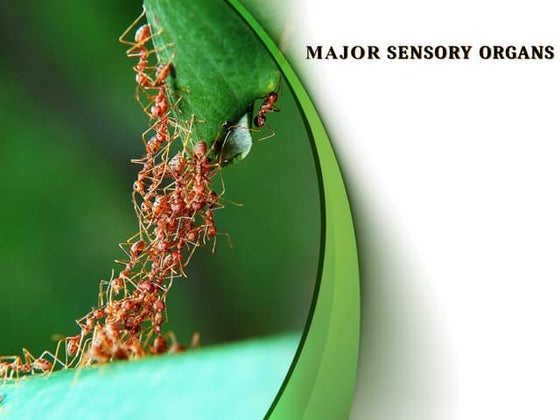



*"Sensing the World: Insect Sensory Systems"*Arshad Shaikh
Ã˝
Insects' major sensory organs include compound eyes for vision, antennae for smell, taste, and touch, and ocelli for light detection, enabling navigation, food detection, and communication.Myopathies (muscle disorders) for undergraduate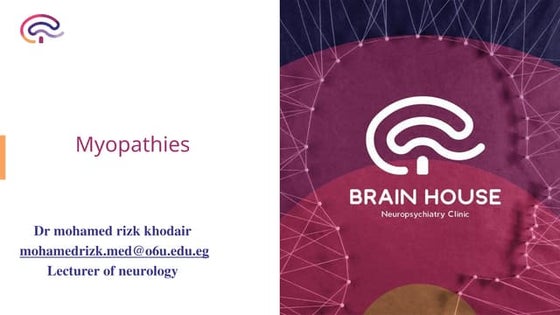



Myopathies (muscle disorders) for undergraduateMohamed Rizk Khodair
Ã˝
herediatary myopthies
myotonia
inflammatory myopthiesRock Art As a Source of Ancient Indian History



Rock Art As a Source of Ancient Indian HistoryVirag Sontakke
Ã˝
This Presentation is prepared for Graduate Students. A presentation that provides basic information about the topic. Students should seek further information from the recommended books and articles. This presentation is only for students and purely for academic purposes. I took/copied the pictures/maps included in the presentation are from the internet. The presenter is thankful to them and herewith courtesy is given to all. This presentation is only for academic purposes.How to Clean Your Contacts Using the Deduplication Menu in Odoo 18



How to Clean Your Contacts Using the Deduplication Menu in Odoo 18Celine George
Ã˝
In this slide, we’ll discuss on how to clean your contacts using the Deduplication Menu in Odoo 18. Maintaining a clean and organized contact database is essential for effective business operations. How to Manage Upselling in Odoo 18 Sales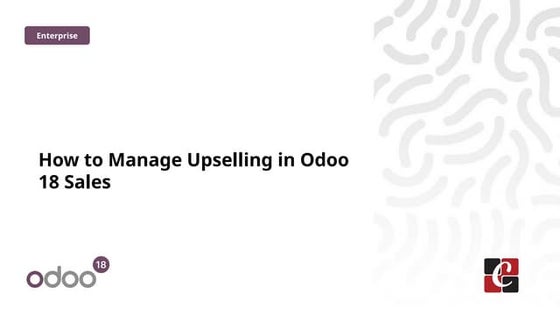



How to Manage Upselling in Odoo 18 SalesCeline George
Ã˝
In this slide, we‚Äôll discuss on how to manage upselling in Odoo 18 Sales module. Upselling in Odoo is a powerful sales technique that allows you to increase the average order value by suggesting additional or more premium products or services to your customers.Form View Attributes in Odoo 18 - Odoo ∫›∫›fl£s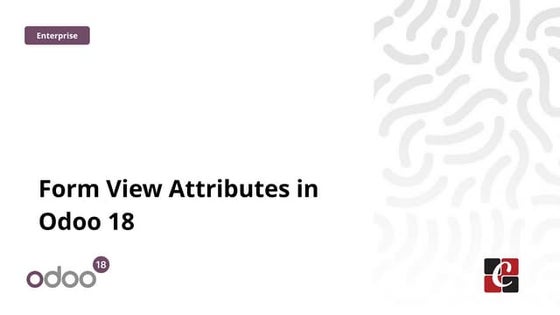



Form View Attributes in Odoo 18 - Odoo ∫›∫›fl£sCeline George
Ã˝
Odoo is a versatile and powerful open-source business management software, allows users to customize their interfaces for an enhanced user experience. A key element of this customization is the utilization of Form View attributes.Overview Well-Being and Creative Careers



Overview Well-Being and Creative CareersUniversity of Amsterdam
Ã˝
∫›∫›fl£s to support presentations and the publication of my book Well-Being and Creative Careers: What Makes You Happy Can Also Make You Sick, out in September 2025 with Intellect Books in the UK and worldwide, distributed in the US by The University of Chicago Press.
In this book and presentation, I investigate the systemic issues that make creative work both exhilarating and unsustainable. Drawing on extensive research and in-depth interviews with media professionals, the hidden downsides of doing what you love get documented, analyzing how workplace structures, high workloads, and perceived injustices contribute to mental and physical distress.
All of this is not just about what’s broken; it’s about what can be done. The talk concludes with providing a roadmap for rethinking the culture of creative industries and offers strategies for balancing passion with sustainability.
With this book and presentation I hope to challenge us to imagine a healthier future for the labor of love that a creative career is.Ajanta Paintings: Study as a Source of History



Ajanta Paintings: Study as a Source of HistoryVirag Sontakke
Ã˝
This Presentation is prepared for Graduate Students. A presentation that provides basic information about the topic. Students should seek further information from the recommended books and articles. This presentation is only for students and purely for academic purposes. I took/copied the pictures/maps included in the presentation are from the internet. The presenter is thankful to them and herewith courtesy is given to all. This presentation is only for academic purposes.How to Configure Public Holidays & Mandatory Days in Odoo 18



How to Configure Public Holidays & Mandatory Days in Odoo 18Celine George
Ã˝
In this slide, we’ll explore the steps to set up and manage Public Holidays and Mandatory Days in Odoo 18 effectively. Managing Public Holidays and Mandatory Days is essential for maintaining an organized and compliant work schedule in any organization.Ancient Stone Sculptures of India: As a Source of Indian History



Ancient Stone Sculptures of India: As a Source of Indian HistoryVirag Sontakke
Ã˝
This Presentation is prepared for Graduate Students. A presentation that provides basic information about the topic. Students should seek further information from the recommended books and articles. This presentation is only for students and purely for academic purposes. I took/copied the pictures/maps included in the presentation are from the internet. The presenter is thankful to them and herewith courtesy is given to all. This presentation is only for academic purposes.MEDICAL BIOLOGY MCQS BY. DR NASIR MUSTAFA



MEDICAL BIOLOGY MCQS BY. DR NASIR MUSTAFADr. Nasir Mustafa
Ã˝
MEDICAL BIOLOGY MCQS
BY. DR NASIR MUSTAFAantiquity of writing in ancient India- literary & archaeological evidence



antiquity of writing in ancient India- literary & archaeological evidencePrachiSontakke5
Ã˝
for the students of BA SemLDMMIA Reiki News Ed3 Vol1 For Team and Guests



LDMMIA Reiki News Ed3 Vol1 For Team and GuestsLDM Mia eStudios
Ã˝
Happy May and Taurus Season.
♥☽✷♥We have a large viewing audience for Presentations. So far my Free Workshop Presentations are doing excellent on views. I just started weeks ago within May. I am also sponsoring Alison within my blog and courses upcoming. See our Temple office for ongoing weekly updates.
https://ldmchapels.weebly.com
‚ô•‚òΩAbout: I am Adult EDU Vocational, Ordained, Certified and Experienced. Course genres are personal development for holistic health, healing, and self care/self serve.Transform tomorrow: Master benefits analysis with Gen AI today webinar, 30 A...



Transform tomorrow: Master benefits analysis with Gen AI today webinar, 30 A...Association for Project Management
Ã˝
The History of Kashmir Karkota Dynasty NEP.pptx



The History of Kashmir Karkota Dynasty NEP.pptxArya Mahila P. G. College, Banaras Hindu University, Varanasi, India.
Ã˝
BÀI TẬP BỔ TRỢ TIẾNG ANH 9 THEO ĐƠN VỊ BÀI HỌC - GLOBAL SUCCESS - CẢ NĂM (TỪ...



BÀI TẬP BỔ TRỢ TIẾNG ANH 9 THEO ĐƠN VỊ BÀI HỌC - GLOBAL SUCCESS - CẢ NĂM (TỪ...Nguyen Thanh Tu Collection
Ã˝









